Ryan Hall's Blog, page 141
August 10, 2017
10 Fall Races That You Can Still Register For
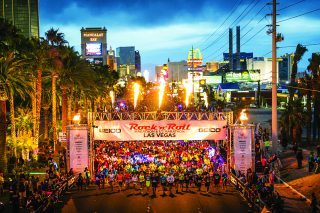
Rock 'n' Roll Las Vegas Marathon & 1/2, Photo: Courtesy of Rock 'n' Roll Marathon Series
Most runners know the big fall marathons: Chicago, New York, Marine Corps. Chances are any runner training for those races signed up way back in the spring (or before) and have had their fall plans set ever since. But what about the last minute runner? The one who is training right now, but has yet to select and register for a race? The good news is that as of right now, there are still so many amazing half marathons and marathons that are still open. Take a look at this list to find your fall goal race.
Medtronic Twin Cities Marathon
Oct. 1, Minneapolis
tcmevents.org
Just because you didn’t get into Chicago or NYC doesn’t mean you can’t run a city marathon this fall. This flat course winds you through the city streets of Minneapolis, as well as city parks with views of fall foliage. There is also a 10-miler, 10K and 5K.
Rock ‘n’ Roll Marathon Series
Dates and locations vary
runrockandroll.com
Pick a geographic location in the United States (and beyond) and chances are there is a Rock ‘n’ Roll race happening nearby. Every Rock ‘n’ Roll race has a half marathon, but at least half also have the option for a full 26.2. Fall races include Las Vegas, Philadelphia, Denver, Savannah and Los Angeles, among others.
Mount Desert Island Marathon
Oct. 15, Bar Harbor, Maine
runmdi.org
Not every fall race has to be flat. Head all the way north for this beautiful but challenging race. There are numerous hills, but with each ascent, runners are rewarded with amazing views. The race ends with a finish line festival in Southwest Harbor, giving runners a tour of the island and a chance to eat lobster when they finish.
Halloween Half Marathon
Oct. 21, Morristown, NJ
superheroracing.com
Racing doesn’t always have to be so serious. Have a little fun at this scenic fall race that features candy at every water stop and jack-o-lantern medals. There are great prizes for the overall winners, but don’t forget about dressing up. Awards are also given to the best costumes.
Jazz Half Marathon
Oct. 28, New Orleans
jazzhalf.com
Halloween in New Orleans can definitely be crazy. So why not start a wild weekend with 13.1-mile run. The course goes through the Garden District, with gorgeous homes all decorated for the holiday. The after-race party is filled with delicious food, lots of beer and, of course, jazz music. Score tickets to the Voodoo Music Experience, also taking place in the city that weekend, if you can’t get enough music.
RELATED: Which Fall Marathon Rules: Chicago Or New York?
Indianapolis Monumental Marathon
Nov. 4, Indianapolis
monumentalmarathon.com
In its 10th year, this race has grown to be one of the largest marathons in the U.S. In addition to a beautiful course that tours the city, runners also love this race due to the great swag and convenience for out-of-town runners. It’s also a rare Saturday marathon. Run early and take the entire weekend to rest and recover. The marathon is open now, but will sell out before race day. The race also has a half marathon, 5K and kids race.
RunDisney Wine and Dine Half Marathon
Nov. 5, Orlando, Fla.
rundisney.com
Believe it or not, this Disney race is still open. Run through Disney World in the morning and come back later that night for an exclusive post-race party at Epcot filled with delicious food and drink. Act fast though—this is one of their most popular races and is sure to sell out soon.
Rocky Run
Nov. 11, Philadelphia
rockybalboarun.com
First off, this is not a typical half marathon. It isn’t even technically a continuous half marathon. Participants in the Italian Stallion challenge start the 5K race and then go right into the 10-mile race. It may be unconventional but it is all fun and perfect for anyone who literally wants to follow in Rocky’s footsteps.
California International Marathon
Dec. 3, Sacramento, Calif.
runsra.org
Chicago isn’t the only speedy fall marathon out there. If you’re looking to run fast on a flat course, this race is for you. Many runners leave Sacramento with a new PR and you could be one of them. Plus, the December date means that runners still have plenty of time to train.
BMW Dallas Marathon
Dec. 10, Dallas
bmwdallasmarathon.com
As the weather gets cold up north, head to Texas for a race in the Lone Star State. The Dallas marathon course has a mix of city streets and beautiful bike trails. It’s the spectators, standing outside in costume and waiting to cheer, that make this race truly great.
RELATED: 8 Weeks To A Fall Marathon Finish Line
The post 10 Fall Races That You Can Still Register For appeared first on Competitor.com.
Norovirus At World Champs Prompts No Hugging Rule

Photo: Courtesy of iaaf.org
A norovirus spreading at IAAF World Champs has prompted changes, both big and small, from meet officials and teams.
Several athletes were placed under quarantine for 48 hours. One of those affected was Botswana’s Isaac Makwala. He was barred from Monday’s 200-meter heats and Tuesday’s 400-meter final due to the virus. Makwala was seen as the main rival to world record holder Wayde van Niekerk in both events. After the decision was met with significant criticism, Makwala was allowed to run a solo 200 meters on Wednesday in an attempt to make the semi-finals. His time of 20.20 sent him to the semis, where he qualified for the finals two hours later.
Other teams affected included Germany, Canada, Ireland and Puerto Rico. Ireland’s Thomas Barr withdrew from the 400-meter hurdles, while Canada’s Eric Gillis dropped out of the marathon at mile 20. Blame has been placed on the Tower Hotel, where all the sickend athletes were staying.
Some changes have been small, but necessary. German athletes arriving later in the week were sent to a different hotel, and told not to come in contact with those affected. They even instilled a post-race no hugging rule.
“We are only allowed to high-fives with our elbows,” German 200-meter runner Rebekka Haase told dw.com.
RELATED: Weekend Highlights From IAAF World Championships
The post Norovirus At World Champs Prompts No Hugging Rule appeared first on Competitor.com.
4 Ways Running Can Help With Anger Management

When Ed Helms’ character, Andy, loses his temper and punches a hole in the wall in a memorable episode of “The Office,” he’s required to take a long leave of absence from work while attending an anger management course. For the rest of us with anger issues, there’s thankfully a more feasible option: running.
While exercise, in general, can be a good outlet for releasing your emotions, running can be a particularly effective mechanism for managing anger—and thus one explanation for the familiar saying, “Running is cheaper than therapy.” A 2007 study at Yale University revealed that prolonged running changed the expression of at least three dozen genes in the brain associated with mood. And the growing consensus is that because running and other forms of aerobic exercise boost levels of serotonin, they have a “prophylactic effect” on anger, in the words of expert Dr. Nathaniel Thom, in a 2010 article in The New York Times.
There are some practical ways to maximize the anger management potential of those early morning jogs and sweaty sessions on the treadmill. In short time, you’ll be turning a regular discipline of running into a constructive, therapeutic outlet for managing your temper.
Run before (as opposed to after) you might blow your lid.
That’s Dr. Thom’s recommendation (in the same New York Times article cited above). Specifically, “If you know that you’re going to be entering into a situation that is likely to make you angry, go for a run first.”
That insight stems directly from the findings of a 2010 study that Dr. Thom conducted at the University of Georgia. His team of researchers put a group of men with “high trait anger” (a.k.a. a short fuse) in front of anger-inducing images, and then asked them to rate their anger. On some days the men did this exercise after sitting quietly, while on other days they did it after 30 minutes of exercise. The men were better able to self-regulate anger and their expressions of it when they had exercised beforehand.
What’s the takeaway? Planning ahead for situations in your day or week that are likely to set you off can help you maximize the prophylactic effects of a run. What’s key is to schedule a run before you find yourself in these situations, rather than after. (There is in fact new evidence to suggest that vigorous exercise during an anger episode may in fact be harmful to your health.) If your daily work commute can cause you to blow a fuse before you have even set foot in the office, take a run before you leave in the morning rather than waiting to work out later in the day.
You might even benefit from listing circumstances and situations that cause you to self-combust, so that you can be strategic about planning a running schedule that will best compensate for these anger and rage triggers. In other words, think of running as a pre-emptive tool for anger management, as opposed to a post-tantrum coping mechanism.
Meditate before you run.
Together, these two disciplines of running and meditation can optimize the growth of new neurons in the brain (via running) and the sustenance of these new neurons (via meditation)—especially in the hippocampus region of the brain, which is one of a number of key sites involved with emotions like anger. For patients with severe depression who reportedly combined meditation with a running routine, the results were very encouraging: a 40 percent decrease in symptoms of major depression. Moreover, studies that have explored the effects of meditation and, separately, the effects of running on the brain, have found that both activities enlarge the size of the hippocampus, thus promoting better mental and emotional health.
What are the anger management benefits in particular, then, of combining meditation with running? The hippocampus is where your brain produces new nerve cells every time you blow a fuse and find yourself in fight or flight mode. Strikingly, too, researchers at the Moscow Institute of Physics and Technology have now found that with an accumulation of anger incidents over time, (with each of these incidents producing more new nerve cells), the brain’s anger and aggression response only increases, thus perpetuating the anger cycle.
Meditation and running, in contrast, can directly offset these negative effects of anger on the brain, building your resilience to future flare-ups.
RELATED: 3 Apps That Help Runners Stay Mentally Strong
Give yourself a pep talk while you run.
This approach is loosely inspired by cognitive behavioral therapy (CBT), an evidence-based strategy for anger management. If you are someone who benefits from exercising when you’re angry, why not add some self-talk therapy to the mix?
CBT works to change unhealthy behaviors that are attached to unrealistic thoughts, and in many cases, how we manage our anger is directly related to what we are thinking about a particular situation. Sometimes reframing our thoughts in relation to a given situation can lower blood pressure by putting things into perspective. At other times, a word of positive affirmation can be just what is needed to calm down.
If you have a running partner you trust, talking with them about what’s eating you can add therapeutic value to your daily exercise, but self-talk can also be very effective. You can literally tell yourself, in between running breaths, to calm down, that there is a solution to the problem at hand, and that everything is going to be all right. You can also reason with yourself, by asking yourself whether being angry will help or hurt in solving the problem at hand. It’s okay to acknowledge your anger, too, and accept it without judgment—as a normal and potentially constructive tool for guiding future choices.
Incorporate techniques athletes use for keeping their cool.
Athletes who are at the top of their game have to learn how to master a wide range of emotions, anger being one of them. To keep their cool, these world-class athletes employ a number of techniques, from role-playing exercises to visualizations and deep breathing.
But you don’t have to be a world-class athlete to practice many of these same techniques. Take deep breathing, for example. Three long, simple breaths before and after you run—or, alternatively, some intentional, rhythmic breathing during a run—can (literally) help you catch your breath when your anger is through the roof. You’ll notice how your mind and body immediately relax.
RELATED: 10 Mental Health Benefits Of Running
***
About the Author
Anna Ciulla is the Clinical Director at Beach House Center for Recovery where she is responsible for designing, implementing and supervising the delivery of the latest evidence-based therapies for treating substance use disorders.
The post 4 Ways Running Can Help With Anger Management appeared first on Competitor.com.
August 9, 2017
Which Foam Roller Should You Use?

Foam rollers are oddly-shaped contraptions but they are extremely versatile in their function and use. You can use them to stretch, increase balance, improve your flexibility and even to enhance exercises. But in most cases, you’ll want a foam roller to work out knots in your muscles.
They come in different colors and sizes, which have different surfaces and densities. With all of these varieties, it’s confusing to pick the best one for you. A rule of thumb I use—if it doesn’t hurt anymore, move on to a denser and different roller.
Check out these varieties and see what may work best for you.
Low density foam roller
This option is great for beginners or those looking for low pressure. It is also good for runners who are rehabbing an injury. Start with the full 3’ size.
High-density foam roller
While the surface is still smooth, this is a step up from the standard foam roller. It’s a higher density and will add more pressure. With this high-density roller, you can also choose between firm or extra-firm.
Textured surface foam rollers
These bumps can be intimidating, but they are designed to add even more direct pressure to release the knot. Different patterns are designed to mimic finger or palm pressure, as if you were getting a massage. There are many different brands and textures you can choose from.
Vibrating roller
This rechargeable foam roller uses vibrations with three different speeds that help to loosen up muscles. While this roller may best mimic a massage in reducing soreness, it comes at a cost. It’s significantly more expensive than any other roller.
You can find each of these types of foam rollers in different lengths. The length is your preference. Some give you more room to move around on and some are smaller for travel.
Whether you’re a roll-iever or not, these great choices should get you started. Happy rolling!
RELATED: The Benefits Of Using A Foam Roller
The post Which Foam Roller Should You Use? appeared first on Competitor.com.
5 Pairs Of Headphones That Provide The Perfect Fit
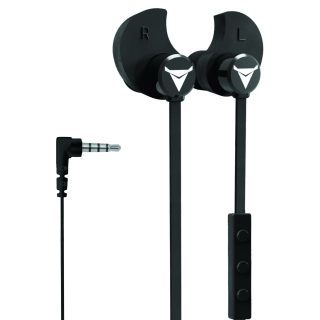
Find your best fit with the latest in music technology that passes the sweat test.
RELATED: Two Runners On Why They Do—And Don’t—Train With Music

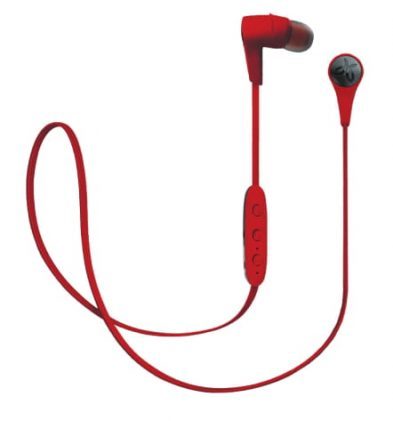
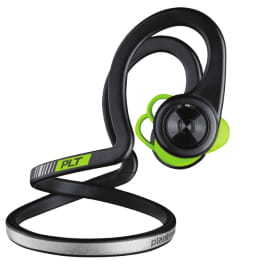

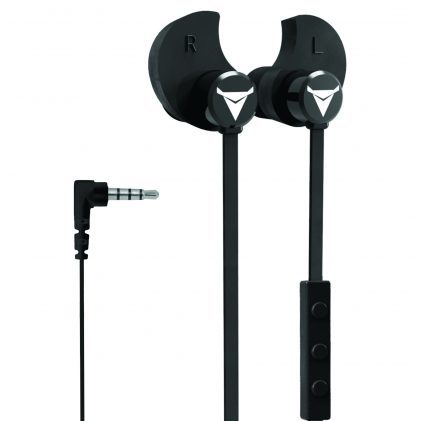
The post 5 Pairs Of Headphones That Provide The Perfect Fit appeared first on Competitor.com.
Farah Advances, Chelimo Takes A Tumble In Men’s 5000m Heats
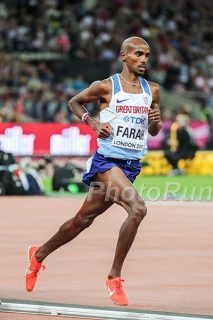
Photo: Photorun.net
Britain’s Mo Farah, who won the 10,000m on the first night of the IAAF World Championships in London, is retaining his 5000m world title by taking second in the first of three 5000m heats behind Ethiopia’s Yomif Kejelcha, 13:30.18 to 13:30.07. It was a messy heat with a lot of pace changes, bumping and shoving.
“I’m a bit tired but you have just got to recover,” said Farah whose team provided him with recovery drinks which were kept in a clear, locked case to thwart tampering. “It is always tough after the 10,000m heats, so I’m just happy to qualify. It is difficult to pick yourself back up and go out there to race so soon. I had to switch off and go again. Rounds are the hardest part.”
Ethiopia’s Muktar Edris finished third and Canada’s Justyn Knight—who avoided trouble by running near the back before sprinting strongly in the final 100 meters—finished fourth. The Syracuse University star was pleased with his run.
“It was fantastic,” Knight told reporters. “I expected that out of championship racing; it’s not going to be pretty. It’s not like it’s a time trial, so nobody’s going to be along the rails for the whole run. But, I tried to stay out of trouble.”
Trouble found Paul Chelimo of the United States, the 2016 Olympic 5000m silver medalist. Nine minutes and three seconds into the second 5000m heat, Chelimo was tripped and both he and Kenya’s Kiprono Menjo went down. Chelimo picked himself up, slowly caught up to the field and ended up finishing eighth with a time qualifier of 13:24.88 (Menjo did not advance).
“It was really wet, so I couldn’t even control myself to stay up,” Chelimo lamented. “So, when I fell down I was like, Paul, I don’t think it’s over, you know? You’ve just got to stand up and get back into it.”
Chelimo’s USA teammate, Ryan Hill, also advanced by finishing fifth in the same heat with a smooth final 100 meters where he kicked down several rivals.
“It was like a December day in Portland,” Hill quipped about the cold and rainy conditions. He continued: “It got really physical and I had to hurdle someone. I didn’t even know Chelimo went down until he passed me. I don’t remember passing him.”
The top-3 finishers in the second 5000m heat were Ethiopia’s Selemon Barega (13:21.50), Bahrain’s Birhanu Balew (13:21.91), and Kenya’s Cyrus Rutto (13:22.45). Australia’s Pat Tiernan, who finished a disappointing 22nd in the 10,000m last Friday, got fifth.
“At the end of the day, like, you get out there and you realize you want to come back again and compete at a top level,” Tiernan told the media.
(c) 2017 Race Results Weekly, all rights reserved
RELATED: Kipruto Wins World Steeplechase Title On Bad Ankle, Jager Claims Bronze
The post Farah Advances, Chelimo Takes A Tumble In Men’s 5000m Heats appeared first on Competitor.com.
London Police Search For Runner Who Pushed Woman In Front Of Bus

Image via Metropolitan Police Service
Shocking footage has been released by London’s CCTV showing a runner on Putney Bridge in southwest London pushing a woman in front of a bus. In the video (below), the bus can be seen narrowly missing the woman and stopping to help.
BuzzFeed News UK reported the 33-year-old woman suffered only minor injuries. “Police added that the jogger returned to the scene 15 minutes later running the other way across the bridge,” they add. “The victim tried to speak to him, but he ignored her and continued running.”
“We are keen to speak to the jogger in the CCTV about what happened that morning,” Sergeant Mat Knowles told BuzzFeed. “We would urge him or anyone who recognizes him to get in touch with us as soon as possible.”
The incident had occurred on an early Friday morning in May, and London police are still in search of the unidentified jogger.
BuzzFeed adds: Anyone with information is asked to contact the Putney Safer Neighbourhood Team on 020 8785 8874 or 101 or tweet @MetCC, or to ring Crimestoppers anonymously on 0800 555 111.
The post London Police Search For Runner Who Pushed Woman In Front Of Bus appeared first on Competitor.com.
Chicago Marathon Welcomes Back 5 Legendary Runners
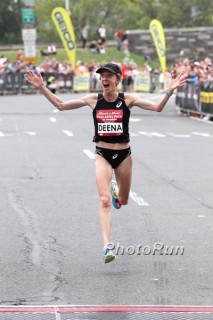
Photo: PhotoRun.net
In celebration of its 40th anniversary, the Chicago Marathon will welcome back five running legends who helped change both the race and the sport itself. Past champions Steve Jones, Khalid Khannouchi, Catherine Ndereba, Paula Radcliffe and Deena Kastor will return as race ambassadors for this year’s marathon. Each of these runners have historic finishes that have helped establish Chicago as one of the world’s premier marathons.
A two-time champion, Jones was the first runner to set a world record at the race, running a 2:08:05 in 1984.
Kannouchi has won Chicago four times. His 1999 victory was perhaps the most exciting, where he set a then-world record of 2:05:42. He was the first man to ever run below a 2:06 in the marathon.
In 2001, Ndereba became the first woman to break the course record, set by Joan Benoit Samuelson. Her time of 2:18:27 was also a new world record. This was the third world record set in Chicago and the first by a woman.
Ndereba’s course and world record stood for only one year. In 2002, she faced off with Radcliffe. In a thrilling race, Radcliffe ultimately took the victory in the record time of 2:17:18.
While Kastor did not set a world record at the Chicago Marathon, she was the last American woman to win. In 2005, she won by five seconds in 2:21:25, still the fifth fastest time ever run by an American woman.
“To have Steve, Khalid, Catherine, Paula and Deena returning to Chicago adds an extra layer of excitement and historic significance to race week as we look forward to celebrating 40 years of one of the greatest marathons in the world,” said Executive Race Director Carey Pinkowski in a statement.
All five runners will participate in marathon weekend events. These include the Abbott Health and Fitness Expo and the Advocate Health Care International Chicago 5K. The Chicago Marathon takes place on Sunday, Oct. 8.
RELATED: Americans Hasay and Rupp Will Race Chicago Marathon
The post Chicago Marathon Welcomes Back 5 Legendary Runners appeared first on Competitor.com.
August 8, 2017
Kipruto Wins World Steeplechase Title On Bad Ankle, Jager Claims Bronze
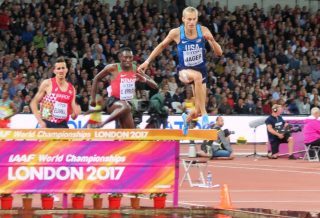
Photo: Jane Monti, Race Results Weekly
Coming into the 16th IAAF World Championships in London, Kenya’s Conseslus Kipruto was worried. The 2016 Rio Olympic steeplechase champion was nursing an injured right ankle and hadn’t finished a race since June 24 when he won the Kenyan Trials in Nairobi.
But the 22-year-old athlete won his preliminary heat here in a solid 8:23.80, and coming into the 3000m steeplechase final he told himself that no matter what, he was still the Olympic champion, still the man to beat.
“I used my plans well, and last night for morale I told myself, ‘I am Olympic champion and that others must break me,” he told IAAF interviewers.
Kipruto kept his plan simple. He would shadow the tall American Evan Jager, a man he knows well and the rival he respected most, and move when the time was right. He had to be patient.
“There are others who are strong but I used my own plans,” he said. “I knew if the race was around 8:10 that I was going to win.”
The opening pace was slow, just 2:51.81 for the first 1000 meters. Jager, who ran a world-leading 8:01.29 in Monaco last month, knew that he had to pick things up. He didn’t want the race to come down to a mass sprint.
“I thought it was going to go a little slow for the first K,” Jager told reporters. “If that happened, we thought it was best, for me, to try to get rid of guys by going hard from three or four laps to go. Basically, you make it a strength race by going a little bit further out.”
RELATED: Weekend Highlights From IAAF World Championships
At the water jump just before four laps to go, Jager gamely bounded to the lead, shadowed by Kipruto and his two Kenyan teammates, four-time world champion Ezekiel Kemboi and Jairus Birech. Morocco’s Soufiane Elbakkali also stayed with the leaders. For three more laps, Jager led the way, shedding everyone but Kipruto, Elbakkali and Kemboi by the bell. Kemboi would soon fall off the pace, too.
“I just wanted to make it hard,” Jager explained. “It’s tough, it’s hard to run over half the race from the lead.”
Going down the backstretch, Kipruto leaped to the lead with one lethal move. Both Jager and Elbakkali gave chase, but Kipruto continued to pull away, taking the final water jump first and having plenty of daylight on his challengers in the final 120 meters of the steeplechase. Looking at the crowd, beating his fist against his racing uniform, and finally punching the air, he crossed the line in 8:14.12 with his first world title. He had been second at these championships in both 2013 in Moscow and 2015 in Beijing.
“I’m happy to be world champion [in the steeplecahse],” he declared. “Last year I became Olympic champion and this year to be world champion was my hope.”
Elbakkali went past Jager before the final water jump and was a clear second in 8:14.49. Jager had to hustle in the final 30 meters to stay ahead of a hard-charging Mahiedine Mekhissi of France, but the American was able to claim bronze in 8:15.53 to the Frenchman’s 8:15.80.
“I peaked up at the big screen just to be safe,” Jager recalled when asked about when he realized that his bronze medal might be in jeopardy. He continued, “I looked back and I was like, oh my gosh, I hope I have enough left. He always has a big last kick.”
Kemboi, 35, who will likely retire after tonight’s race, faded to 11th in 8:29.38. Jager’s USA teammate, Stanley Kebenei, finished fifth in 8:21.09 in his first IAAF World Championships.
(c) 2017 Race Results Weekly, all rights reserved
RELATED: Kipyegon Prevails Over Simpson In Close Women’s 1500m
The post Kipruto Wins World Steeplechase Title On Bad Ankle, Jager Claims Bronze appeared first on Competitor.com.
Two Runners On Why They Do—And Don’t—Train With Music

Music or nature? One runner shares why they train to tunes, while another explains why she leaves the headphones at home.
Pardon Me While I Rock Out
By Kevin Gemmell
The first thing I do when making a playlist is to find a goopy Debbie Gibson song—something that takes me back to junior high and awkward hands-on-hips slow dancing. “Lost in Your Eyes” is a good one. Why?
Motivation, of course. But it’s not what you think. At the end of my standard loop around my neighborhood (about a 5K), there is a 200-yard hill with an approximate 6 percent incline. I put Debbie at the end of my playlist with the hopes that I will never hear her. Because if I’m grinding through that final uphill push and I hear Debbie, I know I haven’t properly paced myself.
For me, music is as much a timing mechanism as motivation.
There are those who dig the R&B umph, umph, umph beat. And that’s great. I’m not one to tell others how to run. But I’m a rock guy, and my playlist reflects that. When I run, I’m “Livin’ on a Prayer.” I literally want “Kickstart My Heart” to do just that, so when I’m done my hat “Smells Like Teen Spirit.”
There is a place in my ears for 80s glam rock, 90s grunge and gritty 2K rock (Audioslave’s “Shadow on the Sun” is a great slow burn to start your run … RIP Chris Cornell).
A part of me envies runners who don’t use music, but can still find that head space to embrace their Zen between each step and breath. But then Skillet reminds me to “Feel Invincible,” and I let the music carry my legs as I sing along (sometimes in my mind, sometimes out loud. I’m not always sure which).
Debbie will always have a place in 13-year-old Kevin’s heart. But for 40-year-old Kevin, she’s best kept out of his buds. Some things are better left in your “Electric Youth.”
RELATED: Scientific Proof That Music And Running Are A Good Mix
The Joy Of Leaving Tunes Behind
By Amanda Loudin
I love music. It is the background of my daily life with my playlists spinning away while I cook, clean or get ready for the day. I’m a proud card-carrying supporter of my local member-supported radio station. Heck, I even bought Bruce Springsteen tickets while perched on a chairlift last year on a ski trip.
In spite of all that, there’s one place I never bring my music: on my runs. In 20 years of running, I have never positioned an earbud to accompany my miles.
There are a myriad of reasons, chief among them the fact that running for me is a multi-sensory adventure. I hear the songs of waking birds, take in the wildlife along the path or trail and smell the muddy stream as I run alongside it. If I’m running with friends, there are miles of shared conversation to enjoy.
There’s also the fact that my solo efforts serve as time for letting my mind roam. As a writer, I find that many of my article ideas spring to life while I’m in motion. I can’t help but think music would interfere with that process.
If I’m racing, I tend to be an associative runner, taking stock of my energy output, breathing and how my legs are feeling. I think I’d be less in tune with my body’s needs if my focus was on a song. Plus I like hearing the sounds of a race all around me
Finally, there’s the safety issue. I will admit that I never bring a phone or rarely tell my family my intended course. But one thing I do to increase my safety is allow my hearing to be unencumbered.
I understand that I’m in the minority. That’s fine with me. I’ve always beat to my own drum.
RELATED: How Running and Music Intersect For RAC’s Liz Anjos
The post Two Runners On Why They Do—And Don’t—Train With Music appeared first on Competitor.com.
Ryan Hall's Blog
- Ryan Hall's profile
- 21 followers



